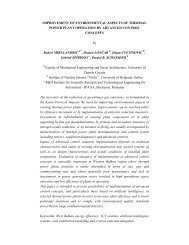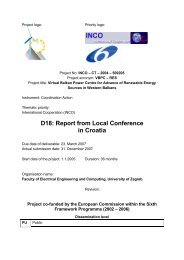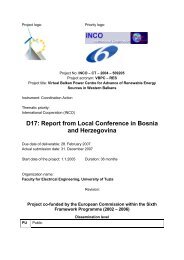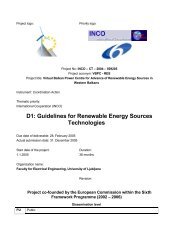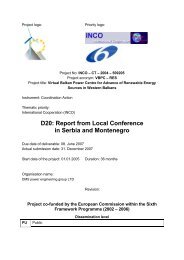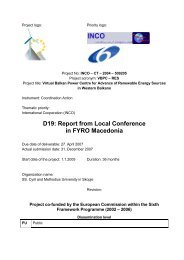Prva stran - WBC-INCO Net
Prva stran - WBC-INCO Net
Prva stran - WBC-INCO Net
Create successful ePaper yourself
Turn your PDF publications into a flip-book with our unique Google optimized e-Paper software.
elongs to the not very prosperous Donji Lapac County.<br />
Prior to the last War in the region, the village comprised 65<br />
households, now only seven are inhabited periodically.<br />
Villagers come mostly during the summer time, in an effort<br />
of restoring their property and repairing the demolished<br />
houses. Many are planning on returning permanently if the<br />
living conditions in the village would improve.<br />
Only one house has been inhabited permanently for the<br />
last three years. The house was rebuilt by the authorities.<br />
The 220V AC installations in the house were provided with<br />
renovation. It is a simple and small single-level building,<br />
presently occupied by three persons. Their only occupation<br />
has been agriculture and goats rising. Providing<br />
refrigerating facilities, they would like to start cheese<br />
production and diversification of other products. For all<br />
these activities a supply of at least some electricity is<br />
indispensable.<br />
After a thorough analysis of first priority needs and daily<br />
habits for such typical household, a power demand curves<br />
were constructed, and presented in Fig.1.<br />
kW<br />
0.2<br />
0.18<br />
0.16<br />
0.14<br />
0.12<br />
0.1<br />
0.08<br />
0.06<br />
0.04<br />
0.02<br />
0<br />
1 3 5 7 9 11 13 15 17 19 21 23<br />
hours<br />
Jan.(kW)<br />
Feb.(kW)<br />
Mar.(kW)<br />
Apr.(kW)<br />
May (kW)<br />
June(kW)<br />
July (kW)<br />
Aug. (kW)<br />
Sept.(kW)<br />
Oct.(kW)<br />
Nov.(kW)<br />
Dec.kW)<br />
Fig.1: Graphical presentation of the estimated first priority loads, given as<br />
averaged monthly values in hourly time intervals.<br />
First priority electricity load consists of several lightbulbs,<br />
a freezer, a water-pump and some small appliance,<br />
like cellular phone charger or similar. Expected electricity<br />
load data were organized in a standardized way, as averaged<br />
monthly values given in hourly time intervals.<br />
IV. TECHNICAL ASPECTS<br />
A. Solar radiation and climatic data<br />
For any location the reliable knowledge of global (total)<br />
solar irradiation is essential for the evaluation of solar<br />
potential and for the prediction of the performance of any<br />
solar-based device. In fact, values of both components of<br />
global radiation on horizontal planes– direct component<br />
(H_Bh) and diffuse component (H_Dh) need to be known,<br />
since for real, inclined receiving plane (say, roof) the diffuse<br />
component remains unchanged while the density of direct<br />
component can be increased by proper inclination and<br />
orientation. Generally, the long-term data (10-year average<br />
or longer) are necessary, but the number of meteorological<br />
stations in Croatia having such data is quite small. In this<br />
work, we have used Meteonorm computer program whose<br />
predictions of global radiation on horizontal planes at<br />
locations far away from measuring station are very reliable<br />
(to be presented elsewhere).<br />
Monthly average of global radiation on horizontal<br />
surfaces (GlobHor) in kWh/m 2 per month, for one of the<br />
locations (Busevic), is shown in Fig. 2 as sum of Direct<br />
component (H_Bh) and Diffuse component (H_Dh) of solar<br />
radiation. Note that direct (beam) solar irradiation prevails<br />
in summer and diffuse irradiation in winter months.<br />
kWh/m2 month<br />
220<br />
200<br />
180<br />
160<br />
140<br />
120<br />
100<br />
80<br />
60<br />
40<br />
20<br />
0<br />
Busevic<br />
Inlands Location<br />
H_Dh<br />
H_Bh<br />
Jan Feb Mar Apr May Jun Jul Aug Sep Oct Nov Dec<br />
Months<br />
Fig. 2 Basic solar data for a representative mountain location<br />
B. Simulation of technical performance and economics of a<br />
solar PV-based system<br />
In this section, we present results of computer<br />
simulations for a stand-alone PV system (consisting of PV<br />
panels, battery, inverter, charge controller, etc) or for a PVgenset<br />
hybrid system. Sizing of system components<br />
depends, of course, on the expected load. Two loads (and<br />
than two sizes of PV- systems) are analyzed. First priority<br />
electricity load, labeled L1, consists of several light-bulbs<br />
(11 W each), a freezer (150 W), a water-pump (75 W) and<br />
some small appliance, like cell phone charger and radio,<br />
totaling about 1.7- 1.9 kWh/day, or 677 kWh/year. Total<br />
monthly load is about 60 kWh/month. Load estimates are<br />
based on priorities from the interview with household<br />
members, and on the assumed normal size higher quality<br />
appliances (class A). If very energy efficient, but also more<br />
expensive and not always readily available (class A+)<br />
appliances would be used, L1 would be lower, or the same<br />
L1 would include also some additional appliance (like TV),<br />
but that will not affect seasonal variation of the load.<br />
C. Basic PV-based solar system<br />
The PV-produced power is still relatively expensive and<br />
must not be wasted. Therefore, to minimize surpluses and<br />
waste, the PV system was dimensioned to completely satisfy<br />
basic electricity needs only when the solar supply is highest,<br />
i.e. during summer months. That implicates that electricity<br />
needs at other seasons will be covered only partly. We have<br />
performed a number of simulations with different loads,<br />
sizes and types of all elements of the PV system, and some<br />
examples are shown here. In the first example, a basic PV<br />
500 Wp system (Wp denotes peak-watt, which is defined as<br />
the energy produced under standard conditions, i.e. 1000<br />
W/m 2 of solar radiation at 25 o C) includes an array of high<br />
efficiency (13.3%) monocrystalline silicon modules with<br />
total surface area of 3.8 m 2 , and a set of batteries of total<br />
capacity 400 Ah.<br />
The analysis of seasonal variation has shown that L1 is<br />
pretty constant throughout the year: while the expected<br />
consumption of light-bulbs will be higher in winter months<br />
(shorter days) the electricity consumption of a freezer will<br />
be lower (smaller temperature difference between freezer set<br />
temperature and air temperature in the surroundings,<br />
especially if the freezer is placed (as expected and also<br />
3



